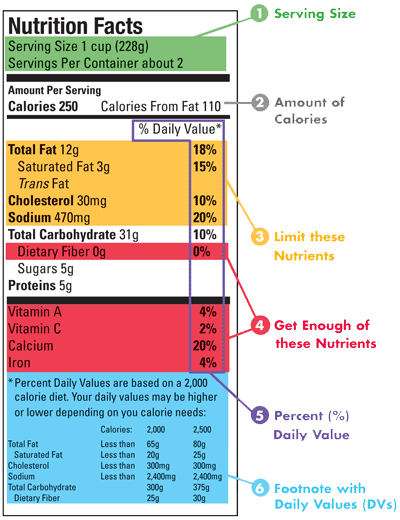44 reading nutrition fact labels
How to Read Nutrition Facts Label - Food Network This carries over to all the other nutrients on the label. If 1 serving of a food has 120 mg of sodium, it can technically be labeled as a "low sodium" food. However, if you eat 3 servings, triple... Nutrition Facts Labels - How to Read - For Kids - Dr. Smarty Nutrition Facts Labels - How to Read - For Kids - Animation for American Nutrition facts labels explained.
Reading Nutrition Labels - Cronometer Key features include: Energy measured in kilojoules only. (we will only report the kcal value in your Cronometer nutrient summary, but you can view the kJ value within the nutrition label view) Serving sizes measured in grams, including a 100g serving size option. Vitamin C, Vitamin A, Calcium, Iron.

Reading nutrition fact labels
nutritionaustralia.org › category › fact-sheetsCategory: Fact Sheets | Nutrition Australia Fact Sheets Nutrition and healthy eating resources. ... Food label reading guide. Reading food and drink labels can help us make healthy choices. Understand what the ... Interactive Nutrition Facts Label - Food and Drug Administration Explore the Nutrition Facts Label and discover the wealth of information it contains! Nutrition Facts. 4 servings per container. Serving size 1 1/2 cup (208g) Amount Per Serving. 240. Calories % Daily Value* 5%. Total Fat 4g. 8%. Saturated Fat 1.5g. Trans Fat 0g. 2%. Cholesterol 5mg. 19%. Sodium 430mg. 17%. Understanding Food Nutrition Labels | American Heart Association Make sure you get enough of the nutrients your body needs, such as: calcium, choline, dietary fiber, iron, magnesium, potassium, and vitamins A, C, D and E.* 5 - Understand % Daily Value. The % Daily Value (DV) tells you the percentage of each nutrient in a single serving, in terms of the daily recommended amount.
Reading nutrition fact labels. The New Nutrition Facts Label | FDA The U.S. Food and Drug Administration (FDA) has updated the Nutrition Facts label on packaged foods and drinks. FDA is requiring changes to the Nutrition Facts label based on updated scientific ... Label reading fact sheet | Baker Institute Label reading This fact sheet gives you guidance on understanding how to read nutrition information panels to help you identify healthy choices. This fact sheet will allow you to identify processed and packaged foods that are: lower in energy (kJ) lower in saturated and trans fat lower in sugar lower in sodium (salt) higher in dietary fibre. How to Read Supplement Labels Like a Pro - Healthline Ingredients. When selecting a supplement, reading the ingredient label is key. Check carefully for ingredients like fillers, sweeteners, preservatives, and additives, all of which will be listed ... How to Read a Nutrition Facts Label - Everyday Health When reading a nutrition facts label, look at the serving size first. "This helps put the nutrient information into context and allows comparison between products," says Goergen. Serving size is...
The Nutrition Facts Label: Look for It and Use It! | SNAP-Ed Read the Label includes lots of tips and challenges created especially for you! These printable activities help you learn more about servings, calories, and nutrients. So, get started today. You'll learn a lot and have fun when you Read the Label! Website Nutrition Facts Label (PDF,566 KB) Funding Source Food and Drug Administration Free Material Food Labels 101: Understanding the Nutrition Facts Label Nutrition labels can be a great tool for managing a heart healthy diet, which makes it very important that you understand what you're looking at when you read a label. Nutrition labels are based on a daily 2,000 calorie diet. Depending on your age, gender and activity level, you may need to consume more or less than 2,000 calories per day, so ... How to Read Nutrition Labels - HealthHub Nutritional data. Focus on the key nutrients that are important to you. If you are on a diet, look at the energy or calorie values. For people with high blood pressure, zoom in on the sodium value or check the saturated fat and cholesterol amounts if you have high cholesterol. Be mindful of fat content; no more than 30 per cent of your daily ... PDF MOVE! Nutrition Handout N10: How to Read a Nutrition Facts Label size" is the official term used on food labels. Nutrition facts given on the food label are based on one serving. Be sure to look at the number of servings in the container. Even small containers may have more than one serving. If you eat the whole container, then you must multiply the nutrition values by the number of servings in the container. 2 Amount of Calories The calories listed are for one serving of the food.
Nutrition: How to Read a Nutrition Facts Label - familydoctor.org The nutrition facts label tells you what's in the food you're eating. It helps you determine if you have a healthy, balanced diet. Every packaged, or processed, product should have a label. Some restaurants also have nutrition facts information available. The label includes amounts in the areas below. › - › mediaLabel reading fact sheet | Baker Institute Label reading Nutrition Information Panel To compare products, use the targets below: Sodium (salt) Aim for less than 400mg per 100g. Less than 120mg per 100g is better. Energy For snacks, aim for less than 600kJ per serve. Saturated fat Aim for less than 2g per 100g. Oils, cheese, nuts and seeds will have more saturated fat. › fact-fiche-engUsing the Nutrition Facts Table: % Daily Value serving sizes) in the Nutrition Facts tables. Cracker A has 9 crackers and weighs 23 grams. Cracker B has 4 crackers and weighs 20 grams. Because the weights are similar, you can compare these Nutrition Facts tables. READ the % DVs Since you are comparing crackers, you may want to look at the % DVs for saturated and trans fats, sodium and fibre. How to Use the Nutrition Fact Label, Eat Right, NHLBI, NIH Get enough of these: potassium, fiber, vitamins A and C, calcium, and iron Use the Percent Daily Value (% DV) column when possible; 5% DV or less is low, 20% DV or more is high Visit the Smart Food Shopping page and learn how the label can help you choose foods lower in calories, fat, and added sugar to help maintain a healthy weight.
Food label reading guide | Nutrition Australia What to look for when reading food and drink labels (per 100g) Health Star Ratings The Health Star Rating is a front of pack labelling scheme which can be used to make healthier food choices at a glance. The rating range is from ½ - 5 stars and the more stars, the healthier the choice. Recommended minimum star ratings for food and drink categories
› food › nutritionThe Basics of the Nutrition Facts Label - Eatright.org Mar 04, 2022 · The following is a quick guide to reading the Nutrition Facts label. Step 1: Start with the Serving Size. Look here for both the serving size (the amount people typically eat at one time) and the number of servings in the package. Compare your portion size (the amount you actually eat) to the serving size listed on the panel.
How to Read Nutrition Facts Labels - Action for Healthy Kids Choosing foods that have smaller percentage Daily Value for saturated fat, added sugars and sodium. A small percentage or low amount of a specific nutrient is considered 5% DV or less. Choosing foods that have higher percentage Daily Value for vitamins, minerals and fiber. A higher percentage of a specific nutrient is considered 20% DV or more.
Learning To Read Labels :: Diabetes Education Online The "Nutrition Facts Label" is found on the outside of the container. To count carbohydrates, look at three things: Serving Size Number of Servings Per Container Grams of Total Carbohydrate per serving The total carbohydrate tells how many grams of carbohydrate are in one serving. Be careful when reading the label.

How to Read a Nutrition Label | Reading food labels, Nutrition facts label, Nutrition labels
Food label reading: Read before you eat - PMC Sir, Nutrition information on food labels is regarded as a major means for encouraging consumers to make healthier choices when shopping for food.[1,2] However, do consumers notice such labels, do they read and understand them, and do they make use of them in their purchasing decisions?A range of consumer research studies[3,4,5] have tried to shed light on these questions.
Quick Tips for Reading the Nutrition Facts Label Quick Tips for Reading the Nutrition Facts Label Use Percent Daily Value (%DV) as a guide. The %DV shows how much a nutrient in a serving of the food contributes to a total daily diet. As a general...

Sample Nutrition Facts label - Mayo Clinic | Nutrition facts label, Nutrition facts, Reading ...
Learn How the Nutrition Facts Label Can Help You Improve Your Health Read the Nutrition Facts labels on your packaged food and drinks to keep track of sugars, fats, protein, and other nutrients. Most sodium we consume is from salt, and salt is commonly in processed foods. Read labels and choose the product with less sodium. Drink plain water instead of sugary beverages.
› food › new-nutrition-facts-labelHow to Understand and Use the Nutrition Facts Label | FDA When looking at the Nutrition Facts label, first take a look at the number of servings in the package (servings per container) and the serving size. Serving sizes are standardized to make it easier...
› health › how-read-food-andHow To Read Food and Beverage Labels | National Institute on ... Feb 24, 2022 · How to read the Nutrition Facts label. The U.S. Food and Drug Administration (FDA) requires a Nutrition Facts label on most packaged foods and beverages. At the top of the Nutrition Facts label, you will find the total number of servings in the container and the food or beverage’s serving size.
› food › food-labeling-nutritionFood Labeling & Nutrition | FDA May 16, 2022 · Food labeling is required for most prepared foods, such as breads, cereals, canned and frozen foods, snacks, desserts, drinks, etc. Nutrition labeling for raw produce (fruits and vegetables) and ...
PDF TO CARE 4 YOURSELF READING A NUTRITION FACTS LABEL - novoMEDLINK READING A NUTRITION FACTS LABEL Strike the right nutrient balance: • Keep these low: saturated fats, trans fats, cholesterol, and sodium • Get enough of these: potassium, fiber, vitamins A, D, and C, calcium, and iron Visit Cornerstones4Care.com for additional resources and to register for a FREE diabetes support program! Point your smartphone

19 best Nutrition Information images on Pinterest | Calorie chart, Exercises and Healthy nutrition
3 Ways to Read Nutrition Facts on Food Labels - wikiHow Protein is essential when it comes to promoting healthy muscle growth and maintaining a good energy level throughout your day. 9. Know that 5% of a daily value per serving is low and 20% is high. When it comes to nutrients, 5% or less is considered low and 20% or higher is considered high.
Reading Nutrition Facts Labels - University of Arizona If you eat both servings then you'll actually eat 500 calories. Look at the percent daily value. As a guideline, a % daily value about 20% is high and below 5% is considered low. So this product is high is Calcium and Sodium, but low in Iron, Fiber and Vitamins A and C. Look out for saturated fat, trans fat, sodium and cholesterol.
PDF How Do I Understand the "Nutrition Facts" Label? "Nutrition Facts" Label? (continued) • Trans Fat - is also considered a "bad fat" because it can raise your LDL cholesterol and your risk of heart disease. Choose foods with "0" grams of trans fat. Read the ingredient list to avoid foods that contain "partially hydrogenated" oils. Everyone can benefit from limiting trans fat.







Post a Comment for "44 reading nutrition fact labels"